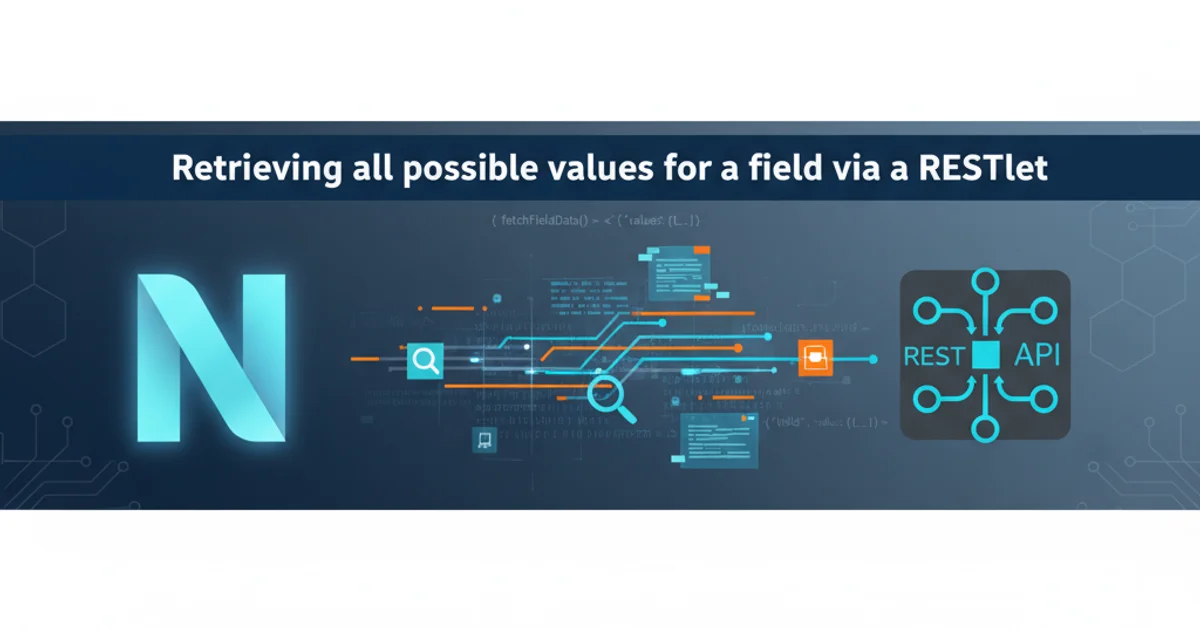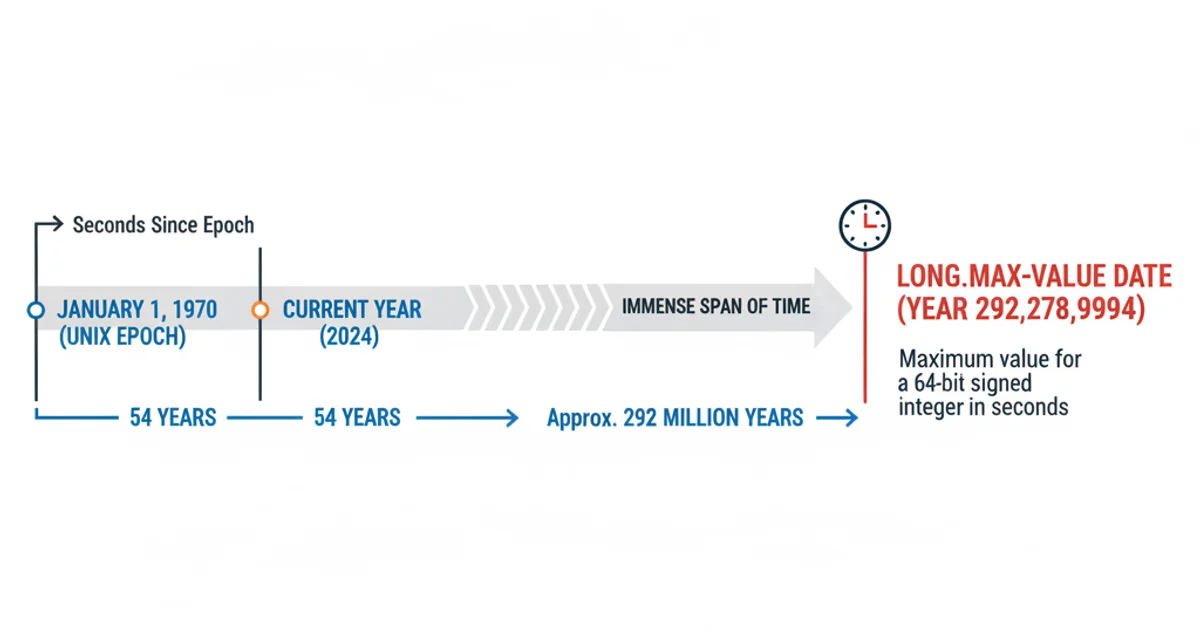Epoch or Unix Time - Long.MAX_VALUE Human Readable Date
Categories:
Decoding Long.MAX_VALUE: The Epoch's Farthest Reach in Human-Readable Time

Explore the implications of Long.MAX_VALUE when interpreted as an Epoch or Unix timestamp, understand its human-readable date, and learn how to handle such extreme values in Java.
Epoch time, also known as Unix time, is a system for tracking time as a single number: the number of seconds that have elapsed since the Unix epoch (January 1, 1970, 00:00:00 UTC). This system is widely used in computing due to its simplicity and universality. However, when dealing with programming languages like Java, the choice of data type for storing these timestamps can have significant implications, especially when approaching the limits of those types. This article delves into what happens when you try to represent Long.MAX_VALUE as a human-readable date, the challenges it presents, and how to correctly interpret and handle such extreme values.
Understanding Epoch Time and Long.MAX_VALUE
In Java, long is a 64-bit signed two's complement integer. Its minimum value is -9,223,372,036,854,775,808 and its maximum value is 9,223,372,036,854,775,807. When an epoch timestamp is stored as a long, it typically represents milliseconds since the epoch. This provides a much finer granularity than seconds, which is often necessary for precise timing in applications.
Long.MAX_VALUE represents the largest possible positive value a long can hold. If we interpret this value as milliseconds since the epoch, we are looking at a date far, far into the future. Understanding this limit is crucial for designing robust systems that handle dates and times, preventing potential overflows or misinterpretations.
Converting Long.MAX_VALUE to a Human-Readable Date
Let's explore how to convert Long.MAX_VALUE (interpreted as milliseconds since epoch) into a human-readable date using Java's java.util.Date and java.time.Instant classes. While java.util.Date is older, java.time.Instant from the Java 8 Date and Time API is generally preferred for modern applications due to its immutability and better design.
import java.time.Instant;
import java.time.ZoneId;
import java.time.ZonedDateTime;
import java.time.format.DateTimeFormatter;
import java.util.Date;
public class MaxLongDate {
public static void main(String[] args) {
long maxLongValue = Long.MAX_VALUE;
// Using java.util.Date (older API)
Date date = new Date(maxLongValue);
System.out.println("java.util.Date representation of Long.MAX_VALUE: " + date);
// Using java.time.Instant (modern API)
Instant instant = Instant.ofEpochMilli(maxLongValue);
System.out.println("java.time.Instant representation of Long.MAX_VALUE: " + instant);
// Formatting with a specific time zone for readability
ZonedDateTime zonedDateTime = instant.atZone(ZoneId.of("UTC"));
DateTimeFormatter formatter = DateTimeFormatter.ofPattern("yyyy-MM-dd HH:mm:ss.SSS 'UTC'");
System.out.println("Formatted ZonedDateTime (UTC): " + zonedDateTime.format(formatter));
// Example with a different time zone
ZonedDateTime zonedDateTimeNY = instant.atZone(ZoneId.of("America/New_York"));
DateTimeFormatter formatterNY = DateTimeFormatter.ofPattern("yyyy-MM-dd HH:mm:ss.SSS z");
System.out.println("Formatted ZonedDateTime (New York): " + zonedDateTimeNY.format(formatterNY));
}
}
Java code to convert Long.MAX_VALUE to human-readable dates.
When you run the above code, you will observe output similar to this:
java.util.Date representation of Long.MAX_VALUE: Sun Aug 17 07:12:55 UTC 292278994
java.time.Instant representation of Long.MAX_VALUE: +292278994-08-17T07:12:55.807Z
Formatted ZonedDateTime (UTC): 292278994-08-17 07:12:55.807 UTC
Formatted ZonedDateTime (New York): 292278994-08-17 03:12:55.807 EDT
As you can see, Long.MAX_VALUE as milliseconds since epoch translates to a date in the year 292,278,994. This is an incredibly distant future date, far beyond any practical human timeline. This demonstrates the vast range that a 64-bit long can represent.

Visualizing the immense span of Long.MAX_VALUE as an epoch timestamp.
Practical Implications and Edge Cases
While it's unlikely you'll encounter Long.MAX_VALUE as a legitimate timestamp in real-world data, understanding its behavior is crucial for several reasons:
- Validation: If your system receives timestamps, validating them against reasonable bounds (e.g., not exceeding a few centuries into the future) can prevent unexpected behavior or errors.
- Serialization/Deserialization: When serializing or deserializing data, especially across different systems or languages, ensure that the timestamp data type can accommodate the expected range. An
int(32-bit) for seconds would overflow much sooner (around 2038, the 'Year 2038 problem'). - Testing: Edge case testing should include maximum and minimum values for timestamps to ensure your application handles them gracefully, even if they are theoretically impossible in production.
- API Design: When designing APIs that return or accept timestamps, clearly document the expected range and units (milliseconds, seconds, etc.) to avoid confusion and errors for consumers.
long. However, always consider the potential for extreme values, especially when dealing with data from external or untrusted sources.Handling Extreme Timestamps in Different Scenarios
Beyond just converting Long.MAX_VALUE, consider how to handle such values in a practical application context. Often, an extremely large timestamp might indicate an error, a placeholder for 'never', or an uninitialized value. Your application logic should account for these possibilities.
java
import java.time.Instant; import java.time.ZonedDateTime; import java.time.ZoneId; import java.time.format.DateTimeParseException;
public class HandleExtremeTimestamp {
public static void main(String[] args) {
long timestamp = Long.MAX_VALUE; // Or some other extreme value
if (timestamp == Long.MAX_VALUE) {
System.out.println("Timestamp is Long.MAX_VALUE, treating as 'Infinity' or 'Never'.");
// Application-specific logic: e.g., display 'N/A', 'Never', or throw an error
} else if (timestamp < 0) {
System.out.println("Timestamp is negative, indicating an invalid or pre-epoch date.");
// Application-specific logic: e.g., treat as invalid, or handle historical dates
} else {
try {
Instant instant = Instant.ofEpochMilli(timestamp);
ZonedDateTime zdt = instant.atZone(ZoneId.systemDefault());
System.out.println("Valid timestamp: " + zdt);
} catch (DateTimeParseException e) {
System.err.println("Error parsing timestamp: " + e.getMessage());
// Handle parsing errors, e.g., log and return default value
}
}
}
}
python
import datetime
Python's equivalent of Long.MAX_VALUE is sys.maxsize for integers,
but for practical epoch time, we'll use the actual value.
Python integers handle arbitrary precision, so no direct overflow like Java long.
Long.MAX_VALUE in milliseconds
max_long_value_ms = 9223372036854775807
Convert milliseconds to seconds for datetime.fromtimestamp
max_long_value_s = max_long_value_ms / 1000
try: # datetime.fromtimestamp expects seconds # Note: Python's datetime has a limited range, typically up to year 9999. # Attempting to convert max_long_value_s will likely raise an OSError or ValueError. # This demonstrates that even with arbitrary precision integers, date objects have limits. date_obj = datetime.datetime.fromtimestamp(max_long_value_s, tz=datetime.timezone.utc) print(f"Python datetime representation of Long.MAX_VALUE (seconds): {date_obj}") except (OSError, ValueError) as e: print(f"Error converting Long.MAX_VALUE to datetime in Python: {e}") print("Python's datetime object has a more limited range than Java's Instant for extreme future dates.")
Example of handling a more 'normal' large timestamp
normal_future_timestamp_ms = 4102444800000 # Jan 1, 2100 00:00:00 UTC normal_future_timestamp_s = normal_future_timestamp_ms / 1000 date_obj_normal = datetime.datetime.fromtimestamp(normal_future_timestamp_s, tz=datetime.timezone.utc) print(f"Normal future timestamp (Jan 1, 2100): {date_obj_normal}")
Custom handling for 'MAX_VALUE' as a special case
def get_human_readable_date(timestamp_ms): if timestamp_ms == max_long_value_ms: return "Never (Long.MAX_VALUE)" elif timestamp_ms < 0: return "Invalid (Negative Timestamp)" else: try: # Convert to seconds for datetime timestamp_s = timestamp_ms / 1000 date_obj = datetime.datetime.fromtimestamp(timestamp_s, tz=datetime.timezone.utc) return date_obj.strftime("%Y-%m-%d %H:%M:%S UTC") except (OSError, ValueError): return "Date out of Python's representable range"
print(f"Custom handler for Long.MAX_VALUE: {get_human_readable_date(max_long_value_ms)}") print(f"Custom handler for normal timestamp: {get_human_readable_date(normal_future_timestamp_ms)}")